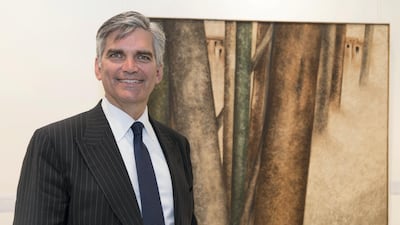Tad Smith gets excited about art - that much is obvious - but he becomes positively animated when speaking about Sotheby’s earnings.
Last year, was “superb, great” for the auction house says the American, who has been Sotheby’s chief executive and president since 2015.
“Do you want specifics?” he asks.
“One, the market recovered very nicely. But two, I will actually give you something to look at,” he says, as he dips into his bag and brandishes a press release with a table of financial highlights comparing the full year 2017 to 2016.
“Look at the table. Everything firing on all cylinders, looking all good,” he says.
It shows that net income at the auction house was up 60 per cent on the year to $118.8 million, and there was a 23 per cent jump in the auction house’s total revenues.
“Sotheby’s is an amazing machine. We generate cash in good years and bad years,” he says.
This year is expected to be another good one. In fact, it will be even better than last, says Mr Smith, who is in the UAE this week to meet current and potential investors in Sotheby’s, attend Art Dubai, and visit Louvre Abu Dhabi – another topic which gets him fired up – for the first time.
“So I saw the Louvre yesterday, and it was a profoundly compelling experience for anyone who has seen a lot of museums. I have seen a lot of museums, you can imagine,” he says.
What the Louvre Abu Dhabi does differently, he says, is to mix artefacts from the same time period to demonstrate the connectedness among humanity.
The result is a powerful, disruptive and new approach to thinking about what a museum should do, he says.
“They are saying 'we are a human species and you can see us whatever religion, whatever culture, whatever geographical tradition we have, we can experience art in ways that are connected',” says Mr Smith.
Given that, does he think Abu Dhabi's purchase last year of Leonardo Da Vinci's painting Salvator Mundi for a reported $450m was necessary?
“The Da Vinci, first of all, because it is a Da Vinci, makes it iconic by definition. So secondly, it says some powerful things about the region,” says Mr Smith.
“It says it’s bold. It says it understands when there is a real opportunity. And, by the way, the marketing value and the awareness-building value and the draw of something like that, puts it in the top level. I can understand why they would have [bought] the Da Vinci. I think it had a lot of positives. And I think it will have a lot of positives for the region, for Abu Dhabi and for the Louvre.”
Louvre Abu Dhabi will achieve a number of things, he says. It will raise awareness among people who are interested in art but it will also act as a cultural draw for the capital for those who are inspired by its curatorial vision and “visually arresting” architectural package.
_______________
Read more:
$155m Picasso spending spree in 2 days for single firm
Inaugural Sotheby's Dubai auction reaps Dh13.2m
_______________
“It packs so much 'wow'. And then, put a Da Vinci on top of it, and not to mention some of the [other] beautiful things I saw yesterday,” adds Mr Smith.
It is his third visit to the UAE since taking over in 2015. Before that and since, Sotheby’s has seen some major growth in its business here.
“[There has been a] 16 per cent increase in the number of Middle East buyers over the [past five years] in our global sales. The number of Middle East bidders has increased by 40 per cent over the past five years. It goes on like that for five pages, again in our global sales,” says Mr Smith, reading from a print-out listing the auction house’s achievements.
Since 2013, Sotheby’s has seen the number of participants from the UAE in its global sales increase by 157 per cent, and from 2016 to 2017 alone, there was an increase of 33 per cent.
The data led Sotheby’s to open its first UAE office in Dubai almost a year ago to the day. Since then, the buyers have kept on coming.
It has been so successful that Sotheby’s is now considering opening one in Abu Dhabi, where there are “tremendous opportunities”, according to Mr Smith.
The growth in the UAE is due to a variety of factors, he says, not least access.
“We are making it easier to do business with Sotheby’s,” Mr Smith says.
Bidders used to have to be in the room or over the phone. Now they can take part in Sotheby’s auctions online. In addition to opening an office in Dubai, it has also held more events such as its first Dubai auction, Boundless, last November, which totalled $3.6m in sales and attracted participants from 33 countries, 30 per cent of whom were from inside the UAE.
Traditionally, buyers in the UAE and wider region have concentrated on Islamic art. They are still buying that. But now they are also buying other things too, including Western art, jewellery and watches, Mr Smith says.
“The opportunity for us is to stay close to the market, understand what the needs are, and anticipate and then by the way, the real magic of what we do is occasionally interest people in something they hadn’t expected to be interested in,” he says.
“Whether we have something unexpected in the travelling exhibition currently underway in Dubai, like a Rubens, or we mix in something else, it is the little magic of the unexpected" that appeals.


